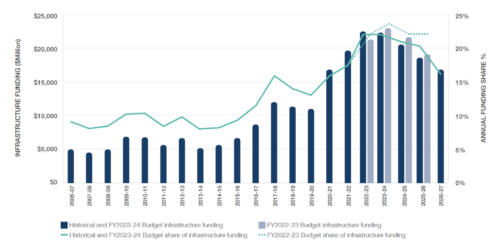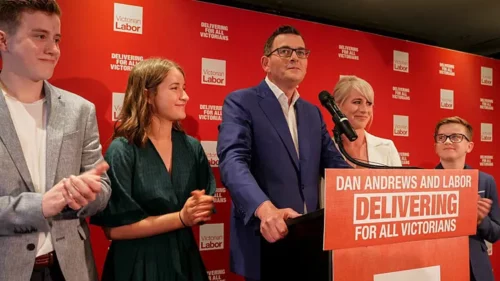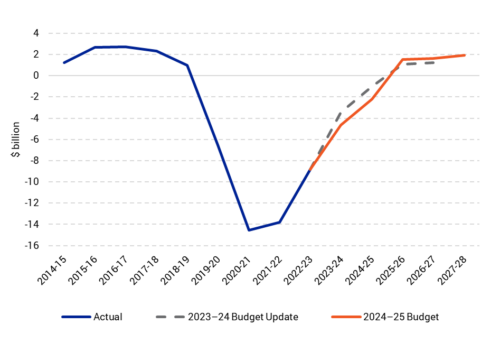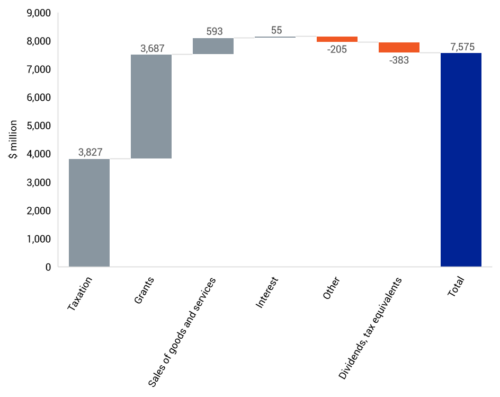

This year’s state budget provided an interesting exercise in messaging from the Victorian Government. Gone were the days of boastful slogan-bashing that Victorians could have it all, infrastructure investment and hospital funding, all the while growing the economy and maintaining fiscal sustainability. In its place are delays, cuts and cancellations, and a tacit admission that the state’s debt must be reined in, albeit not as quickly as some would have hoped. How did we get here? Looking back on the decade-long tenure of the Labor State Government can provide insights into how the fiscal train of good intentions derailed, and how the state can move forward.
Good Times
2014-2019 saw a series of substantial fiscal initiatives by the newly-elected Labor government. Under then-Premier Daniel Andrews, a heavy focus shifted onto infrastructure development, health and education, social services, and most importantly, economic growth.
Infrastructure was a major area of expenditure, with significant projects such as the Melbourne Metro Tunnel and the West Gate Tunnel being fuelled. The government aimed to alleviate congestion and improve connectivity, hence also investing heavily into roadworks across the state (particularly in regional areas).
As observed in the graph below, the fairly consistent rate of spending on infrastructure took somewhat of an exponential turn during the 2014-2019 period (Infrastructure Partnerships Australia, 2023).

The newly-elected Labor State Government placed a heavy emphasis on infrastructure spending (Infrastructure Partnerships Australia, 2023).
Another significant portion of the budget went towards education, with a combined $4 billion in schools, jobs and training at the start of the period followed by continued investment until 2019 (Department of Treasury and Finance, 2014). The government’s sustained efforts towards the development of Victoria’s future workforce was the driver of these investments. A lesser known, but notable emphasis was also placed on social services and community support programs. Investing in public housing initiatives to support disadvantaged communities was put forward to improve the quality of life for vulnerable populations, ensuring more inclusive growth.
Public opinion on the government spending during this time proved to be strongly positive. Many Victorians appreciated the significant investments, recognising the long-term benefits these projects could bring. Improvements in transport, health, and education were generally well-received as they addressed critical needs and aimed to improve the quality of life for residents. If electoral dominance was any barometer of public approval, community sentiment of Victoria’s ‘Big Build’ was overwhelmingly positive.

Then-Premier Daniel Andrews celebrates a ‘danslide’ relection victory in 2018, off the back of a successful public works campaign (Burton, 2018).
While the initiatives were largely viewed as necessary and beneficial for the Victorian economy and welfare, there were doubts surrounding cost management and budget overruns. Like many government plans, there was criticism. Some Victorians felt that the government could have managed these projects more efficiently and were concerned about increasing state debt resulting from such extensive investments.
A trend that follows many large infrastructures projects though is budget cost overruns, and this case is no exception. Victoria’s ‘Big Build’ faced massive blowouts, with the North East Link running over around $10 billion than originally expected, and the West Gate Tunnel now at nearly double the expected budget (Parr, 2024). While these overruns are massive, they are not uncommon when it comes to infrastructure projects. However, it points to underlying concerns regarding funding transparency and accountability when it comes to evaluating the feasibility of these projects.
Hard Times
Beginning in 2020 with catastrophic bushfires, the Australian people were off to a devastating start with damages to homes and infrastructure. These fires cost the Victorian government over $2.1 billion in net present value terms, including expenditures for emergency response and immediate recovery ($54.5 million), support for communities and infrastructure ($420 million), wildlife and environmental conservation (approx. $22 million), and community engagement and recovery (Department of Treasury and Finance, State of Victoria, n.d.).
In the wake of the bushfires, the COVID-19 pandemic dealt a two-part blow to the Australian economy, requiring unprecedented stimulus to revive aggregate demand while simultaneously depleting the state’s revenue sources. The state’s expenditures targeted several critical areas to support the existing healthcare infrastructure. Its largest policies included Public Health Initiatives and Healthcare System Support.

The ‘two-part’ blow of COVID-19 and bushfires deteriorated Victoria’s fiscal standing, neccesitating substantial stimulus (AAP, 2020).
The budget was not only directly affected by the increase in state expenditure to stimulate the economy but also by a significant reduction in tax revenue due to the lockdowns. Although it is impossible to get an accurate value of how much the government lost in revenue, the government implemented further reductions in taxation, which further brought the budget into deficit. Notable policies enacted included Land Tax Relief, Payroll Tax Waivers, and Stamp Duty Concessions.
Land tax relief was provided to landlords who offered rent reductions to tenants experiencing financial distress due to the pandemic. This initiative aimed to provide dual benefits, offering tenant relief and landlord support, as tenants were under pressure from the dramatic increase in the unemployment rate and businesses moving remotely, and landlords who were struggling to receive payments from their struggling tenants.
Additional relief given to landlords included temporary stamp duty concessions that were introduced to stimulate the property market, including reductions for purchases of new residential properties and vacant land. These measures included a waiver of 50% of the stamp duty for new residential properties with a dutiable value of up to $1 million and a 25% reduction in stamp duty for existing residential properties with a dutiable value of up to $1 million. A 50% stamp duty concession was also offered for eligible regional, commercial or industrial property acquisitions from 27 January 2020 in the defined State of Disaster Local Government Areas (Mortgage Express, n.d.). Furthermore, the state government implemented policies to defer various tax payments while waiving many staple fees and charges, which contribute significantly to the state’s revenue.
Overall, with the uncertainty that came from the unprecedented circumstances during COVID-19, it is easy for economists to pick and choose where the state may have acted irresponsibly in the management of the budget. However, one fact remains true: the consequences and implications of those fiscal decisions will be seen in the years and decades to come, including in the here and now.
Harder Choices
The 2024-25 Victorian budget is projected to result in an estimated $4.6 billion deficit, a slightly more expansionary budget than the $4 billion deficit estimated last year (Hayward, 2024). Yet the retracted promises – delays in the construction of Melbourne Airport Rail Link amongst other 100 or so projects – is overshadowing the substantial cash and capital injections delivered (The Age, 2024). Ironically, the budget too faces scrutiny for being too expansionary, worsening the state’s debt and contributing to inflationary pressures (Hayward, 2024).
Looking ahead, the state government has predicted a return to budget surplus in 2025-26, supporting the state in financing its debt (Hayward, 2024). It signals a shift from expansionary budgets during the pandemic, to more contractionary budgets in the upcoming years. This changing budgetary stance reflects changing economic circumstances, rather than the change in leadership, given Premier Jacinta Allan’s commitment to developing the Suburban Rail Loop as Minister for Transport previously (The Age, 2024). Rather, rising construction costs of the Airport Rail, and growing debt has forced the government to choose winners and losers.

The state’s Net Operating Balance is expected to narrow in the coming years, with a forecase surplus to come in 2025-25 (Parliamentary Budget Office, 2024).
With fiscal priorities going forward becoming returning to a budget surplus, it raises the question of how the state government may do so. Aside from being aided by any economic upturn, one way is to cut spending. The government would want to strike a tricky balance between achieving economic outcomes and managing the public’s expectations.
Another way is to increase taxes; or rather, allow wage rises to effectively increase tax revenue. The Federal government has used this phenomenon, referred to as bracket creep, to alleviate post-pandemic debt (Parliamentary Budget Office, 2021). Victoria may anticipate something similar, since payroll taxes, stamp duty and land taxes are its top three tax revenue sources (Chwasta, 2024). However, whilst population and housing prices are on an overall upwards trajectory, the volatility of the housing market may pose risks if the housing market underperforms, resulting in uncertainty on receipts from stamp duty (Bleby, 2024).

Despite raised revenue forecasts, the government expects larger deficits in the years to come (Pariliamentary Budget Office, 2024).
Additionally, the federal government could provide funding, though the extent that federal revenue trickles down to each state can fluctuate. Notably, the added GST granted to Victoria this year may neither continue into the future, nor be enough to fully alleviate the state’s budgetary pressures (Smethurst, 2024).
Another question to ask is how much debt is sustainable and how does the state avoid long-term debt build-up. Following conventional Keynesian thought, the budget should counter-cyclically stabilise the economy, seeing increasing discretionary spending when the economy needs to, and less when the economy does not (Hayward, 2024). This, alongside fluctuating business cycles and terms of trade affecting growth and employment, naturally leads to deficits and surpluses, and some level of debt. Theoretically, in the long-term, the surpluses and deficits will offset each other, so the important aspect is choosing which areas to spend on (Jericho, 2024).
However currently, achieving budget surpluses to reduce debt is crucial. Increasing debt levels in recent years has led to the state’s credit rating to fall from AAA to AA, and may fall further if debt continues to rise (McCubbing, G., & Durkin, P., 2024). Lower credit ratings, alongside any further rate rises by the RBA, would augment interest expenses and budgetary pressures. (Hayward, 2024; McCubbing, G., & Durkin, P., 2024). The state may be in a race against time to avoid this spiral of decreasing serviceability of debt and falling credit ratings.
Conclusion
The story of Victoria’s latest budget highlights the importance of maintaining a balanced budget in the long-run and prudent cost management. Without major economic shocks, budget surpluses during upturns are likely to offset deficits during downturns. But it may take much longer to reduce the debt collected from a significant shock like the pandemic. Faced with climate change, an aging population, and a more volatile economic environment, it is more important than ever to build buffers in the budget.
As much as it is about prudent economic management, Victorians also deserve to be included in a mature conversation about the sustainability of the state’s finances. The challenge posed for Allan and her government, a tired, decade-long project, is how to stabilise the fiscal train, without being kicked out of it.
References
The Age. (2024, May 10). State’s finances tied to a runaway debt train of government’s own design. The Age. https://www.theage.com.au/politics/victoria/state-s-finances-tied-to-a-runaway-debt-train-of-government-s-own-design-20240510-p5jcmk.html
Bleby, M. (2024, May 6). Victoria has become a poor state: economist Saul Eslake. Australian Financial Review. https://www.afr.com/property/residential/victoria-has-become-a-poor-state-economist-saul-eslake-20240506-p5fpaj
Chwasta, M. (2024, May 8). Here are seven charts to make sense of the Victorian state budget. ABC News. https://www.abc.net.au/news/2024-05-08/victorian-state-budget-in-seven-charts/103814958
Hayward, D. (2024, May 7). “Eye watering” spending, growing debt make up surprisingly generous Victorian state budget. The Conversation. https://theconversation.com/eye-watering-spending-growing-debt-make-up-surprisingly-generous-victorian-state-budget-229485
Jericho, G. (2024, April 3). Don’t worry about a budget surplus, care about the choices in the budget. The Australia Institute. https://australiainstitute.org.au/post/dont-worry-about-a-budget-surplus-care-about-the-choices-in-the-budget/
McCubbing, G., & Durkin, P. (2024, May 7). Ratings warning over Victoria’s $188b debt. Australian Financial Review. https://www.afr.com/politics/victorian-debt-to-hit-188b-as-labor-budget-shirks-cuts-20240507-p5fph3
Parliamentary Budget Office. (2021). Bracket creep and its fiscal impact. https://www.pbo.gov.au/about-budgets/budget-insights/budget-explainers/bracket-creep-and-its-fiscal-impact
Smethurst, A. (2024, May 14). Victoria’s GST windfall could be short-lived. The Sydney Morning Herald. https://www.smh.com.au/politics/federal/victoria-s-gst-windfall-could-be-short-lived-20240512-p5jcwo.html
Pallas, T. (2019). 2019/20 Budget update. Department of Treasury and Finance, State of Victoria.
Australian Institute of Health and Welfare. (n.d.). Health system spending on the response to COVID-19. Retrieved from https://www.aihw.gov.au/reports/health-welfare-expenditure/health-system-spending-on-the-response-to-covid-19/contents/spending-by-area
Mortgage Express. (n.d.). Changes to stamp duty. Retrieved from https://www.mortgage-express.com.au/blog/changes-to-stamp-duty
The CAINZ Digest is published by CAINZ, a student society affiliated with the Faculty of Business at the University of Melbourne. Opinions published are not necessarily those of the publishers, printers or editors. CAINZ and the University of Melbourne do not accept any responsibility for the accuracy of information contained in the publication.